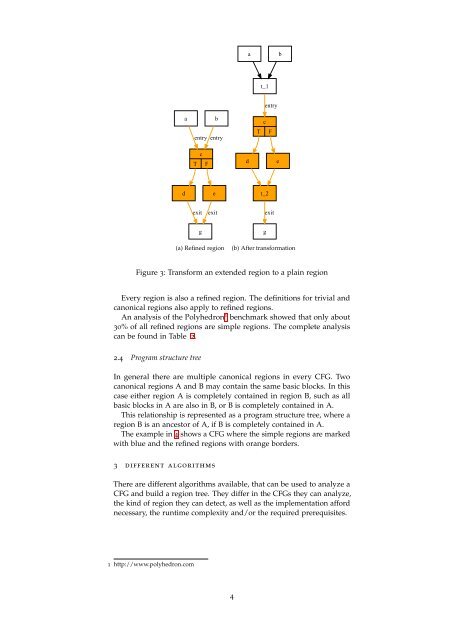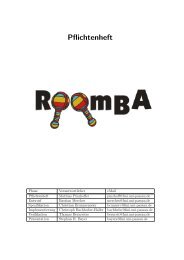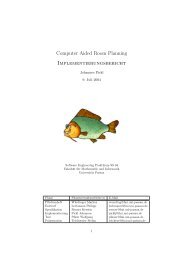PROGRAM STRUCTURE TREES - Software Systems Lab
PROGRAM STRUCTURE TREES - Software Systems Lab
PROGRAM STRUCTURE TREES - Software Systems Lab
Create successful ePaper yourself
Turn your PDF publications into a flip-book with our unique Google optimized e-Paper software.
a<br />
b<br />
t_1<br />
entry<br />
a<br />
entry<br />
b<br />
entry<br />
c<br />
T F<br />
T<br />
c<br />
F<br />
d<br />
e<br />
d<br />
e<br />
t_2<br />
exit<br />
exit<br />
exit<br />
g<br />
g<br />
(a) Refined region<br />
(b) After transformation<br />
Figure 3: Transform an extended region to a plain region<br />
Every region is also a refined region. The definitions for trivial and<br />
canonical regions also apply to refined regions.<br />
An analysis of the Polyhedron 1 benchmark showed that only about<br />
30% of all refined regions are simple regions. The complete analysis<br />
can be found in Table 2.<br />
2.4 Program structure tree<br />
In general there are multiple canonical regions in every CFG. Two<br />
canonical regions A and B may contain the same basic blocks. In this<br />
case either region A is completely contained in region B, such as all<br />
basic blocks in A are also in B, or B is completely contained in A.<br />
This relationship is represented as a program structure tree, where a<br />
region B is an ancestor of A, if B is completely contained in A.<br />
The example in 4 shows a CFG where the simple regions are marked<br />
with blue and the refined regions with orange borders.<br />
3 different algorithms<br />
There are different algorithms available, that can be used to analyze a<br />
CFG and build a region tree. They differ in the CFGs they can analyze,<br />
the kind of region they can detect, as well as the implementation afford<br />
necessary, the runtime complexity and/or the required prerequisites.<br />
1 http://www.polyhedron.com<br />
4







